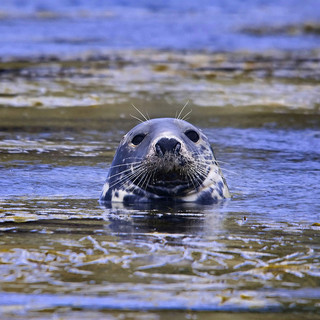Overview

Order: Carnivora
Family: Phocidae
Species: Halichoerus grypus
IUCN Status: Least Concern
Population trend: increasing
Distribution: Widespread in the north-east Atlantic, from Spitzbergen to southern Iceland with the largest numbers in British waters.
Habitat: Open sea, rocky islands & coasts; sometimes found on sandy beaches.
Description: Variable colour; bulls usually darker than cows. Pups are white at birth. Streamlined body, large nose & eyes.
Size: Length: males up to 2.7m; female up to 1.7m. Weight: male up to 233kg; female up to 154kg.
Life-span: 26 -38 years.
Food: Fish, crustaceans & molluscs.
The grey seal is Britain's largest native seal species, being bigger (and slightly confusingly more numerous) than the common or harbour seal. Its thick, insulating layer of blubber and waterproof fur allow it to survive in cold water temperatures.
Read More: The solitary hunter